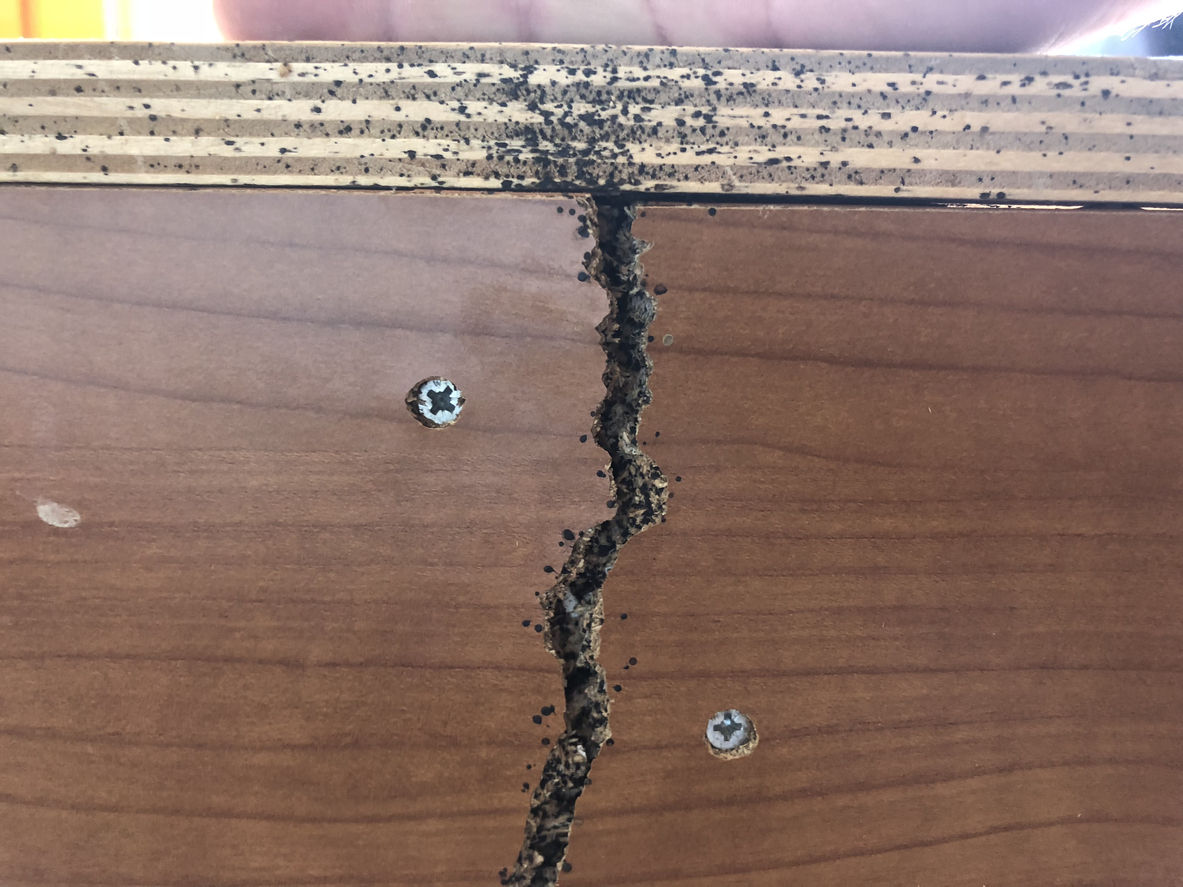

We may earn revenue from the products available on this page and participate in affiliate programs. Learn More ›
Q: I’ve seen some small bugs near the baseboards of my home, along with some small holes in the wood. I’m worried that they might be termites, but I’ve never seen them before in my home, so I’m not positive what termites look like. Are there any bugs that look like termites that these could be, or should I hire an exterminator ASAP?
A: Termites are a homeowner’s worst nightmare—they can cause thousands of dollars of damage to your home’s structure before you even know they’re present. But homeowners don’t have to worry immediately when they spot small bugs around the home. Many insects can resemble termites or display similar behaviors, and while some pests may require the help of an exterminator to remove, others are harmless. If you’re worried about the presence of termites in your home, keep reading to learn about some of the termite’s look-alikes (and see the difference between termites vs. ants), and find out how to identify termites when they’re actually in your home.
Termites can have varying appearances, but they leave telltale signs of their presence around a home.
About 45 species of termites are found in the U.S., meaning that not every termite looks precisely the same. These species fall into one of three categories: subterranean, dampwood, and drywood termites. Termites are generally between ¼ and ½ inches long with rounded bodies that lack a defined waist and have short antennae. Body color ranges from cream to reddish-brown. If a homeowner sees white bugs that look like termites, those are most likely termites, as few other insects of similar shapes and sizes can be as light-colored. Signs of termites include dead winged insects around the home, hollow-sounding wood, unexpected sawdust, or hard-to-open windows.
Flying ants can be confused with termites since both insects fly.
When a homeowner spots termites, they often see the winged termites leaving the original colony to start a new one, meaning the original colony has become too crowded and signaling a severe infestation. These winged termites are the ones that can mate and reproduce. When homeowners spot bugs that look like flying termites, they’ll often see them in swarms. Flying ants move in similar swarming patterns as termites, so it may be natural to confuse the two insects.
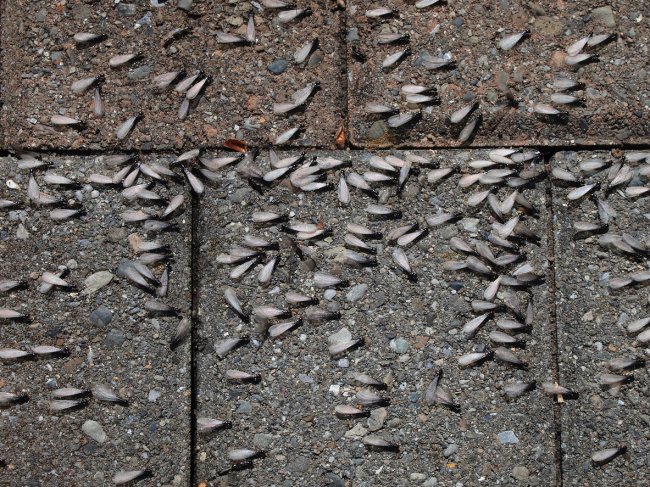
The most significant distinction between flying ants and termites is that flying ants don’t cause any damage, unlike termites, who feed on wood. A termite infestation will be accompanied by small piles of sawdust on surfaces or visible holes where termites have bored.
However, flying ants can still cause an infestation, and like typical ants one would see in or around the home, flying ants will be attracted to food and food debris. If ants that look like termites are spotted but they’re nibbling on pieces of kibble left over in a pet’s food bowl, it’s a sure sign that the insect is a flying ant. Cleaning up food and debris or setting traps can keep flying ants from infesting a home.
Carpenter ants are black bugs that look like termites and damage wood.
Many homeowners may confuse a carpenter ant infestation for a termite one because both tiny pests bore holes into and destroy wood. Carpenter ants can leave small piles of wood debris, known as frass, but often, it’s unlikely that a homeowner would spot frass. Frass is more likely to be stored within the wood void instead of on the ground or windowsill, where sawdust that termites produce would be seen. Carpenter ant holes are also smoother than termite holes—as if sanded or drilled. Termite holes are rougher and have a distinctly “chewed” look.
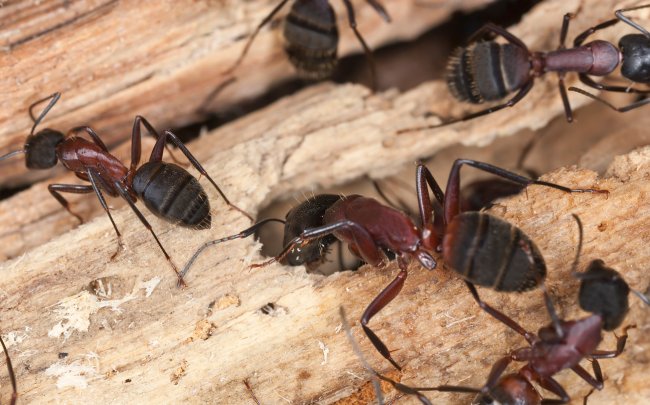
Physically, carpenter ants have a thin, pinched waist; narrow neck; and long legs. Termites have a thicker waist and shorter legs that appear higher up on the body than they would on carpenter ants’ bodies. While both insects have antennae, carpenter ant antennae are bent and segmented. Winged termites have two pairs of evenly sized wings, while carpenter ants have much larger front wings and smaller back wings.
Acrobat ants often nest in voids in wood left behind by termites.
If a homeonwer previously dealt with a termite infestation and now spot insects in the holes and gaps the termites left, they may think you have another termite infestation on your hands. But these insects that look like termites may be acrobat ants. This type of ant often takes up residence where termites have abandoned or been eradicated from. Acrobat ants may leave behind tiny scraps of wood or insulation, but they typically cause less damage than termites. Like carpenter and flying ants, they have a narrower middle than termites and also have bent antennae.
Acrobat ants get their name from their physical reactions when disturbed: standing on their head with their abdomen and legs in the air. These insects can also release a foul smell when disturbed, which may help distinguish them from other ant species or termites.
The holes carpenter bees create can look like termite kick-out holes.
As their name suggests, carpenter bees are another wood-eating insect that leaves behind holes. However, that’s the end of the similarities between carpenter bees and termites. If a homeowner sees a carpenter bee boring into wood, it should be easy to identify it. Carpenter bees are much larger than termites and are chubby and fuzzy like bumblebees (minus the stripes). Carpenter bees don’t live in colonies, so it’s likely to only to see one at a time. Carpenter bee holes are also larger than termite holes and may contain a sticky yellow substance. You can make a carpenter bee trap or contact a local pest control professional to handle the situation.
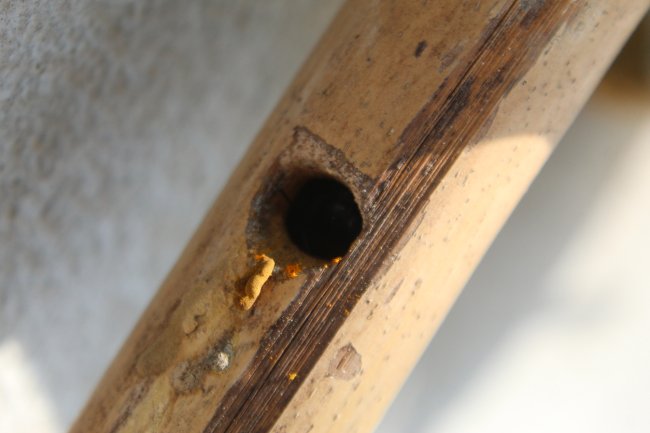
If you’re seeing bugs that look like termites without wings, they might be powderpost beetles.
A powderpost beetle is a bug that looks like a giant termite. It’s another wood-boring insect, but it only eats unfinished wood, whereas termites aren’t as picky. Powderpost beetles only come out at night, so it’s more likely to see the remnants of the beetles’ work than a beetle itself. Powderpost beetles leave holes the size of a pinhead with fine sawdust surrounding them. The body shape is unlike a termite—powderpost beetles have a typical elliptical beetle shape. If a homeowner thinks they have powderpost beetles, it’s still worth calling an exterminator to minimize the amount of damage these insects create.
Mayflies and green lacewings are bugs that look like termites with wings and also swarm.
Carpenter and flying ants aren’t the only bugs with wings that you might confuse for termites. Mayflies and green lacewings are two other small bugs that look like termites with wings. When these bugs are stationary, it should be reasonably easy to distinguish them from termites. All three of these bugs swarm, though, so it can be hard to tell at a glance when these bugs are in motion.
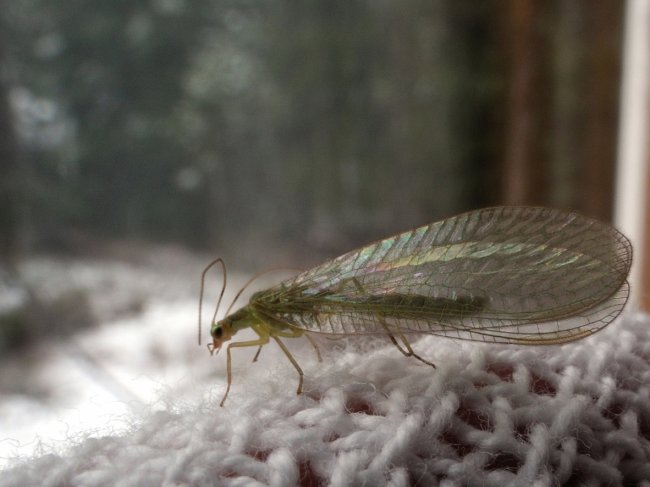
Mayflies spend most of their lives developing in freshwater bodies, so they’re common nuisances to find near rivers, lakes, swamps, or marshes. Like winged termites, mayflies swarm, so a homeonwer might think you have a termite infestation on your hands if they see a lot of small flying bugs in your backyard. Fully grown mayflies are bigger than termites (up to an inch in length). Mayflies also have a distinctive shape, with a long and thin abdomen and two or three thin tails coming out of the end. Mayflies don’t bite or sting, so the only harm they do is cause a nuisance.
Green lacewings are backyard bugs that are very beneficial to anyone with a garden. These insects feed on pests like aphids, spider mites, and mealybugs. While green lacewings have a bright-green color in the warmer months, they turn brown when they overwinter. The brown color combined with four wings of even length can make green lacewings resemble flying termites even more. However, green lacewings also have longer antennae and near-transparent wings, while termites have shorter antennae and more opaque wings.
When in doubt, it’s a good idea to get a termite inspection.
Termites are no joke and can cause severe and lasting damage to a home. Instead of poring over a termite identification chart or asking friends or neighbors for advice, it’s always a safe bet to hire a professional to perform a thorough termite inspection when there’s any question about whether these insects have made their way into a home. The best termite control companies can identify an infestation and use the best termite treatments to eradicate the population effectively.
